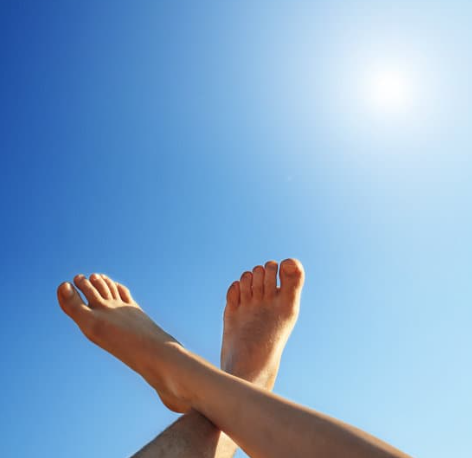What could be the reason of your foot rash? Learn more about feet sunburns
Its been hot and will continue with high temperatures this week coming. Applying a sun factor 50 first to our feet is ideal as we all want to avoid crocodile feet skin!
The sun’s harmful ultraviolet rays can cause sunburns which may result to unfortunate skin damage!
At the end of our Sunday newsletter today, we will discuss more about foot sunburns.
Following on from Lyme Disease last Sunday, there are other foot or ankle rashes that can occur to our feet here is a little information on these conditions:
- Psoriasis (and all its variants) – an autoimmune condition that results in rapid buildup of skin cells, causing thick, scaly patches. It can affect the feet which causes redness, scaling, and discomfort.
- Eczema (and all its variants) – is a chronic skin condition that can affect various parts of the body including the feet. It results to dry, itchy, and inflamed patches of skin.
- Contact Dermatitis – occurs when the skin comes into direct contact with an irritant or allergen, like certain soaps, detergents, or some chemicals. It can cause redness, itching, and sometimes blisters on the feet.
- Hives – is a skin reaction which causes bumps, raised patches, or both to suddenly appear on the skin.
- Poison Ivy, Poison Oak, and Poison Sumac – are blistering skin rashes caused by coming into contact with the oily sap found on these common plants.
- Hand / Foot Mouth Disease – is a common viral infection that commonly affects children under the age of 5 and tends to occur during warmer weather.
- Cellulitis – is a serious bacterial skin infection that can affect any body parts, including the feet. This infection takes place when bacteria enter through a break in the skin.
- Scabies – is an infestation of the skin by mites. Symptoms include intense itching and a pimple-like skin rash.
Walking and even wearing shoes might be a painful ordeal if you have an irritable foot rash. In order to prevent getting foot rashes, dry your feet well and also in between the toes before putting on shoes or socks and protect your feet by wearing shoes especially in public showers, at the gym, and by the pool. Always cover any cuts or wounds on your feet with bandages.
Although the resulting foot rashes may share certain similarities, they need to be treated differently. There are foot creams that the podiatrist may prescribed depending on the cause of your foot rash.
How can we prevent getting sunburns? Sunburn is mainly caused by prolonged exposure to UV radiation from the sun or other artificial sources like tanning beds and elongated periods also can increase heatstroke.
Prevention
Foot sunburns can be quite uncomfortable, considering the sensitivity of the skin on the feet. Preventing sunburn is essential for maintaining skin health. Here are some preventive measures:
- Use sunscreen. Apply a broad-spectrum sunscreen with a high SPF (sun protection factor) of 50 or higher, even on cloudy days. Reapply every two hours or after swimming/sweating.
- Avoid further sun exposure. Keep your feet protected from the sun until they have fully healed. If you need to go outside, wear shoes or sandals that cover your feet and apply sunscreen to any exposed areas.
- Choose appropriate footwear. Opt for loose-fitting, breathable shoes or sandals that do not rub against or irritate the sunburned skin.
- Avoid friction and pressure. Try to minimize any unnecessary pressure or friction on your sunburned feet. This may mean wearing open-toed shoes or sandals instead of tight or closed shoes.
- Avoid tanning beds. Artificial UV radiation from tanning beds can also cause sunburn and increase the risk of skin cancer.
Staying hydrated helps speed up the skin’s healing process. Drink plenty of water especially this hot season. Remember, prevention is key to avoiding sunburn in the first place. Whenever you expose your feet to the sun, follow general sun protection guidelines such as applying sunscreen, seeking shade, and wearing protective footwear.
Did you know Bob Marley had a rogue mole on his foot that unfortunately was the cause of his untimely death? Having our moles checked out is part of your preventative foot and ankle health care. It is best to have your foot and ankle moles checked out by a dermatologist or podiatrist.
Are you suffering from any of these conditions? At The Chelsea Clinic, we can help. One of our podiatrist can assist and then recommend what treatments are best to get you back on track.  Podiatrist South Kensington
Podiatrist South Kensington
Schedule an appointment here or you may call us at +44 (0) 207 101 4000. 
We hope you have a feetastic day! 

-The Chelsea Clinic and Team


 Podiatrist South Kensington
Podiatrist South Kensington




